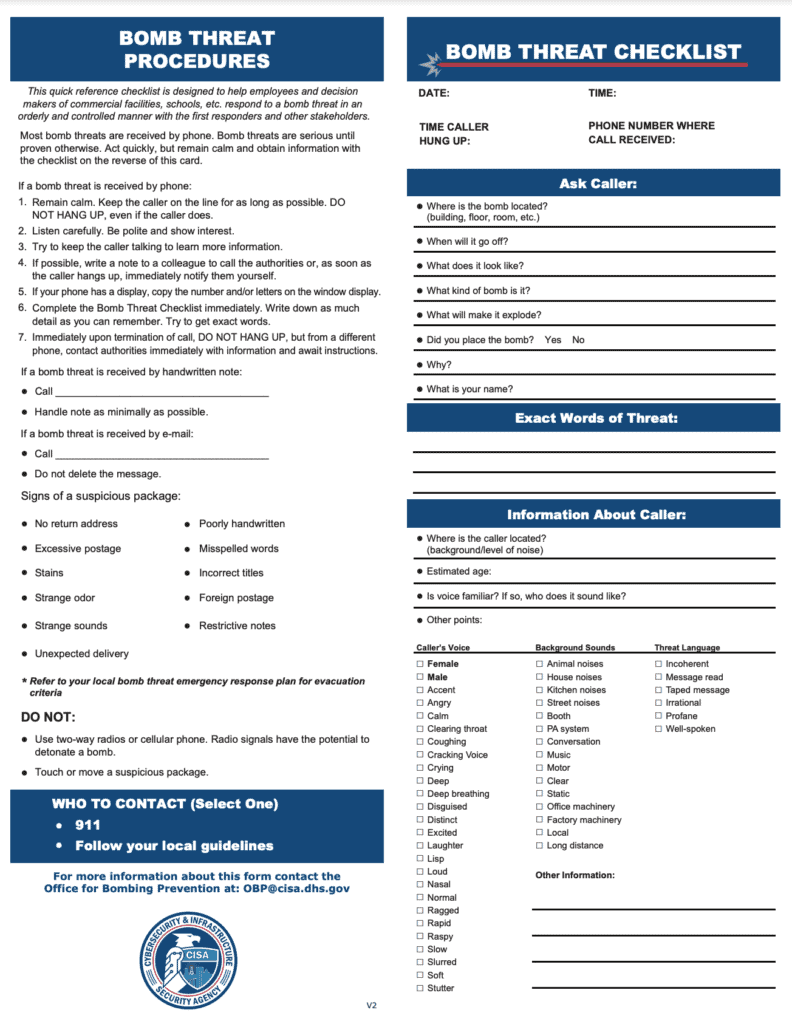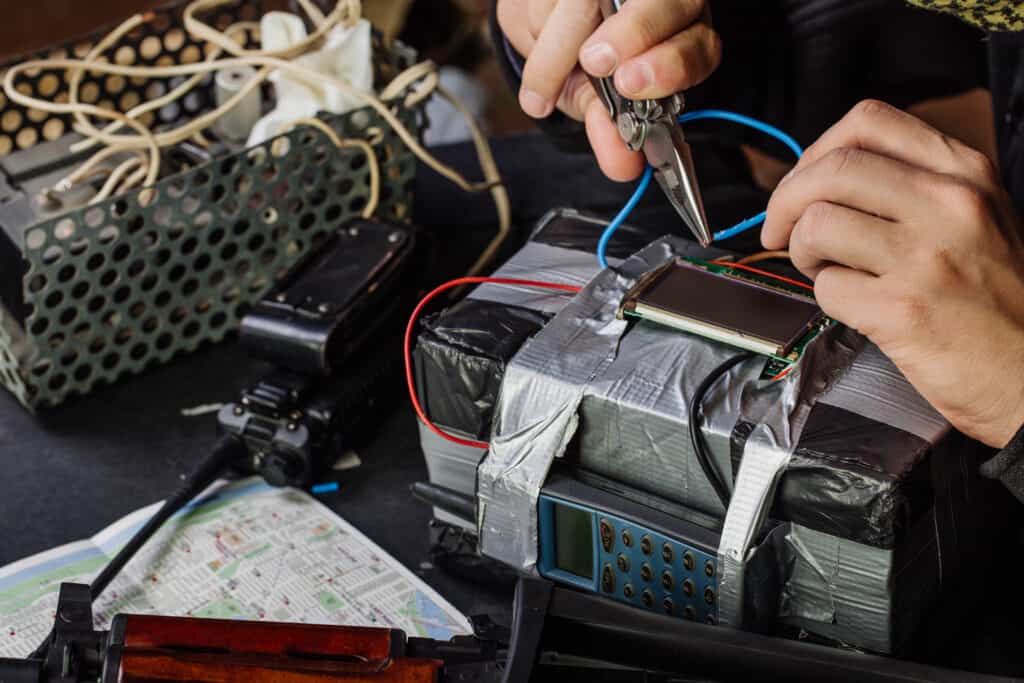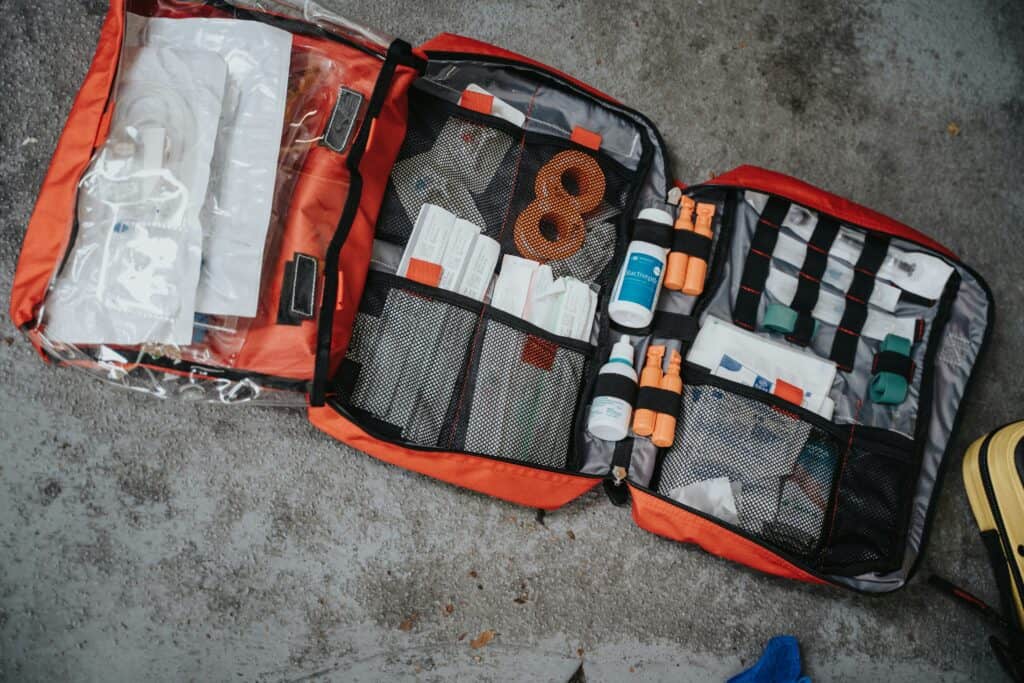Receiving a bomb threat can be a terrifying and stressful experience, but knowing the proper steps to take in such a situation is crucial to ensuring the safety of everyone involved. Bomb threats can come in various forms, such as phone calls, emails, or suspicious packages. Regardless of the method used, it is essential to remain calm and focused, allowing for effective action and communication with the appropriate authorities.
When faced with a bomb threat, immediate steps should be taken to assess the credibility of the threat and secure the safety of those in the affected area. This may involve notifying facility supervisors, law enforcement, or calling 9-1-1 to report the threat. Providing accurate and detailed information about the nature of the threat can help authorities make informed decisions on further actions to be taken.
It is important to remain vigilant and follow any instructions given by authorities or building management during a bomb threat. This may include evacuating the premises or initiating lockdown procedures. By following these guidelines, those affected by a bomb threat can contribute to a safer and more effective response to the situation.
Recognize the Threat
Telephonic Threat
If you receive a bomb threat via phone, remain calm and try to gather as much information as possible from the caller. Using a display phone with Caller ID can help you quickly identify the caller. Pay attention to the caller’s voice, accent, and background noise. Ask the caller about the location and timing of the bomb, as well as the reason for the threat. Remember, during a telephonic threat, maintaining a composed demeanor and engaging the caller in conversation can potentially yield valuable information.
Email Threat
In case of an email bomb threat, do not delete the email and avoid replying to it. Preserve the email as it can serve as important evidence. Analyze the sender’s email address and note the time it was received. Be cautious of any attachments in the email and refrain from clicking on them. Inform your IT department or local law enforcement about the threatening email.
Handwritten Note Threat
If a bomb threat comes in the form of a handwritten note, handle it as little as possible to maintain any fingerprints or evidence on the note. Once you have read the note, secure it in a safe place and contact your facility supervisor or local law enforcement. Pay attention to the handwriting, language, and any distinctive marks or characteristics that may offer clues about the sender.
It is essential to be attentive in recognizing bomb threats through different channels, such as a phone call, email, or written note, and respond accordingly to protect yourself and others in your surroundings.
Responding to a Threat
When faced with a bomb threat, it’s crucial to remain calm and follow a few essential steps. Begin by ensuring you gather as much information as possible during the course of the threat. This may include the time of the call, the caller’s voice, and any background noise.
As you remain calm, be sure to document every detail of the threat and record the call if possible. Be attentive to the specific terms and phrases used by the caller, as this information might be useful for authorities. Facts such as their location, accent, and delivery can play a crucial role in identifying the individual behind the threat.
There are several questions you should ask during the call:
- When is the bomb going to explode?
- Where is the bomb located?
- What does the bomb look like?
- What type of explosive is used in the bomb?
- Why are you making this threat?
Providing precise instructions for those affected by the bomb threat can help save lives and minimize confusion. Have a clear evacuation plan in place and communicate it to everyone in the facility. Chain of command and roles should be well defined, allowing for a more efficient response to the potential emergency.
After the call has ended, immediately report the threat to local law enforcement or call 9-1-1. Share all the information gathered during the call, including the documented details and any specific questions you managed to ask. Liaise with authorities and follow their guidance to determine the next steps, ensuring the safety of everyone involved.
Remember, in a bomb threat situation, it’s essential to stay confident, knowledgeable, neutral, and clear in your communications.
If It’s a Suspicious Package
When encountering a suspicious package or item, it is crucial to remain calm and follow the appropriate steps to ensure one’s safety and the safety of others. A suspicious package could be an envelope, box, or any other object that raises concerns due to characteristics such as a lack of return address, protruding wires, excessive postage, stains, or a strange odor.
If a suspicious item is identified, individuals should refrain from handling the package, moving it, or attempting to open it. These actions could potentially trigger an explosive or harmful substance within the package. Instead, they should maintain a safe distance from the suspicious object and encourage others to do the same.
Once a safe distance has been established, individuals should immediately notify their facility supervisor, if available, or call 9-1-1 or local law enforcement authorities. They should provide information about the item’s appearance and location, and follow any instructions given by the authorities.
As a safety precaution, it is advisable to evacuate the area surrounding the suspicious package. Additionally, individuals should keep their phone lines open and available for communication with the authorities. This will allow for the swift exchange of information and updates on the situation.
By following these guidelines and prioritizing personal safety, individuals can confidently and effectively respond to suspicious packages or items in their surroundings. Remember to always remain vigilant and report any unusual or concerning objects to the appropriate authorities.
Contacting Authorities

In the event of receiving a bomb threat, it is crucial to contact the appropriate authorities immediately. The first point of contact should be the police or local law enforcement. Do not hesitate to dial 9-1-1, as they are trained to handle such situations and will provide immediate assistance. Ensure to provide them with as much information as possible, including the location and any specific details from the threat.
If the bomb threat occurs on a school or university campus, contacting campus police is also necessary. They are well-equipped to deal with emergencies on the premises and will work in tandem with local law enforcement to mitigate the situation. Additionally, inform the building or facility supervisor to ensure everyone in the vicinity is aware of the potential threat.
It is essential to remain calm and clear while communicating the threat to the authorities. Providing accurate information will help the emergency services and law enforcement officers respond quickly and efficiently. As you wait for their arrival, follow any instructions given to you over the phone.
Timely contact with the appropriate authorities, such as the police, local law enforcement, campus police, and emergency services, is crucial when dealing with a bomb threat. Acting swiftly and calmly will ensure proper handling of the situation and minimize potential risks.
Initiating Safety Protocols
In the event of a bomb threat, it is essential to have a well-established emergency plan in place. This plan should include guidelines for building evacuation, communication with emergency contacts, and coordination with emergency responders. The primary goal of these safety protocols is to ensure the well-being of all individuals within the building and to provide clear instructions to follow during this high-stress situation.
First, it is crucial to remain calm when receiving a bomb threat. Taking deep breaths and staying composed will enable individuals to focus on the following procedures. Those in charge of the facility should immediately notify their emergency contact, typically a designated security supervisor or manager, who can enact the emergency plan and alert the appropriate emergency responders.
The emergency plan should include explicit evacuation procedures that outline the safest and most efficient routes to exit the building. Room-by-room instructions and designated assembly areas outside the facility can help ensure an organized and timely evacuation. All building occupants should be notified of the threat and advised to evacuate the premises calmly and quickly. In case of no guidance being provided and feeling immediate danger, distance and protective cover are the best ways to reduce injury.
During evacuation, it is vital to avoid using elevators and to remain aware of the surroundings, including any unusual items or suspicious packages. Being observant and reporting anything out of the ordinary to authorities can aid in the bomb threat assessment and response procedures.
Throughout the entire process, clear communication between building occupants, emergency contacts, and responders is essential. Information should be shared consistently and transparently to ensure everyone is kept well-informed of the current situation and any necessary updates.
By following these safety protocols and maintaining a confident, knowledgeable, and clear approach to dealing with bomb threats, building occupants can increase their chances of staying safe and minimizing harm during such emergencies.
Staff Training
Training staff on how to handle bomb threats is vital for maintaining a safe and secure work environment. It is important for employees to feel confident and knowledgeable in reacting appropriately to such situations.
The first step in staff training is to ensure that all employees are familiar with the company’s emergency response plan. This plan should clearly outline the specific protocols to follow in the event of a bomb threat. Employees should know who to contact, where to gather, and how to evacuate the premises safely.
In addition to understanding the emergency response plan, it is necessary to train employees on how to identify and report a suspicious package. Staff should be aware of common warning signs, such as packages with unusual smells, excessive postage, or poorly written addresses. Hold regular workshops or informational sessions to review these warning signs and provide staff with opportunities to ask questions and clarify their understanding.
Another essential aspect of staff training is fostering effective communication. Employees must know who to contact in the event of a bomb threat, such as a supervisor or local law enforcement. Encourage staff to be vigilant and to report any suspicious activities or objects immediately. Open communication channels and a confidential reporting system can empower employees to take action without fear of reprisal.
Finally, it is crucial to conduct periodic emergency drills to help employees put their training into practice. Simulated bomb threat situations will enable staff to familiarize themselves with evacuation routes and rally points, as well as practice remaining calm under pressure. These drills can further reinforce the importance of following established protocols and procedures.
Training staff to handle bomb threats is a vital aspect of ensuring workplace safety. By providing employees with the knowledge, skills, and resources necessary to respond effectively, you can create a more secure environment for everyone.
Dealing with False Alarms
False alarms can cause panic and confusion and often result in unnecessary allocation of resources and time. It is essential to understand how to deal with such situations effectively to minimize the negative impact on the affected individuals and organizations.
One of the key aspects of handling false alarms is to establish a clear communication channel with the responsible authorities. If a bomb threat is received, promptly call 9-1-1 or your local law enforcement, especially if a facility supervisor is unavailable. Following the Department of Homeland Security (DHS) Bomb Threat Checklist will help ensure a systematic response.

Staying calm and composed is vital when dealing with false alarms. Panic can lead to further confusion and may even exacerbate the situation. Employees and individuals can be trained to respond calmly to such incidents and be prepared to cooperate with authorities when dealing with a potential false alarm.
Implementing a robust threat detection and reporting system is another way to minimize false alarms. For example, having proper security measures in place, such as security cameras and guards, can help identify potential threats or suspicious behaviors, allowing for a better assessment of the situation.
It is also crucial to learn from false alarms to prevent similar situations from occurring in the future. Performing a thorough review and analysis of the incident can lead to a better understanding of the factors that contributed to the false alarms, such as flaws in the reporting system, procedural gaps, or miscommunications within the organization.
Dealing with false alarms requires a combination of effective communication, remaining calm, having reliable security measures in place, and learning from previous incidents. By implementing these practices, organizations can minimize the negative impact of false alarms and create a safer environment for all.
Collaborating with Investigation
When a bomb threat is received, it’s essential to collaborate with the investigation conducted by law enforcement and emergency responders. By providing accurate and timely information to the authorities, you can help in apprehending the perpetrator and ensuring the safety of everyone involved.
Begin by providing investigators with any details about the call, such as the caller’s voice characteristics, accent, and whether the voice was familiar or not. Also, note any background noises that might provide clues about the location of the caller. Every detail, no matter how seemingly insignificant, could be critical to the investigation.
As emergency responders arrive at the scene, ensure that they have access to any available two-way radios to assist with communication. By facilitating their communication, you’re supporting their efforts to locate and neutralize any potential threats.
Stay vigilant and adopt the “see something, say something” mindset. Encourage others to do the same, as everyone’s collective observations can significantly impact the investigation’s outcome. If you or others notice any suspicious activities, items, or individuals, report them immediately to the authorities.
Lastly, remember to act quickly and calmly. Time is of the essence when dealing with a bomb threat, and your prompt actions can be vital in ensuring everyone’s safety. By maintaining a level-headed approach, you show confidence and support the efforts of law enforcement and emergency responders in their endeavors to protect and serve.
Resources and Guides
The Department of Homeland Security and CISA (Cybersecurity and Infrastructure Security Agency) provide valuable resources and guides to help individuals and organizations prepare for and respond to bomb threats. These resources include a bomb threat checklist that can assist in recording essential information during a bomb threat call.
This checklist contains key questions to ask the caller, such as the location of the bomb when it will explode, and what it looks like. It also features a section to document the caller’s voice characteristics and background noises, which could be crucial for law enforcement investigations.
Another valuable resource is the CISA Bomb Threat Guidance, which offers practical advice on how to handle bomb threats and potential evacuations. This guide highlights the importance of having a comprehensive plan in place to manage bomb threat situations, including assembling an emergency response team and training employees on how to recognize suspicious packages.
In addition, the Department of Homeland Security provides general safety tips and recommendations for responding to bomb threats. Their advice emphasizes the significance of promptly notifying law enforcement, preserving evidence, and evacuating the area if necessary. More detailed guidance can be found on their What to Do – Bomb Threat web page.
By utilizing these resources and following the guidance from the Department of Homeland Security and CISA, individuals and organizations can develop effective strategies to manage bomb threats and minimize risk.
Handling Panic Situations
In the event of a bomb threat, it’s essential to remain calm and composed. Panic can lead to poor decision-making and compromise safety. Staying collected and focused during these high-pressure incidents is crucial.
First and foremost, follow the instructions provided by your facility supervisor or law enforcement authorities. They are trained and experienced in handling such dangerous situations. Adhering to their guidance will help to ensure the safety of yourself and others.
It’s also essential to communicate effectively with those around you. Share any crucial information calmly and clearly, without causing unnecessary concern or hysteria. If you are in a position of authority, keep your team informed about the situation and the steps they need to follow.
In case of a bomb threat, evacuating the area safely can help prevent panic. Follow the evacuation plan, stay alert, and move in an orderly fashion to an established safe zone. Avoid using elevators and be prepared to assist anyone with disabilities or young children during the evacuation process.
Lastly, it may be helpful to engage in coping mechanisms to manage stress and anxiety during a crisis. Deep breathing exercises, grounding techniques, or visualizing a calm and safe place can reduce panic and keep you focused on handling the situation effectively.
Remember that staying calm and following proper procedures can significantly reduce the risk during a bomb threat incident. A confident, knowledgeable, and clear-headed approach will ensure both your safety and the safety of others around you.
Frequently Asked Questions
How should I respond to a bomb threat?
If you receive a bomb threat, remain calm and follow these steps: listen carefully, take notes on important details, and try to keep the caller on the line as long as possible. Once the call ends, immediately notify your supervisor and call 9-1-1 or local law enforcement. Report all the information you gathered during the call, referring to the Department of Homeland Security (DHS) Bomb Threat Checklist when necessary.
What precautions should be taken after receiving a bomb threat?
After reporting the bomb threat to authorities, follow any instructions given by law enforcement or your organization’s emergency response team. It is crucial to stay at your current location. Do not attempt to evacuate your area, as you might inadvertently encounter the bomb. Keep yourself and others away from windows, and maintain an open communication line with law enforcement until the situation is resolved.
How can I identify a potential bomb threat?
A bomb threat is often communicated through phone calls or written messages with specific language or details. Be vigilant and attentive to any unusual behavior, such as abandoned bags, packages, or vehicles appearing suspicious in nature. Ultimately, trust your instincts and immediately report any concerns to law enforcement.
Why is it important to keep the caller on the line during a bomb threat?
Keeping the caller on the line during a bomb threat increases the chances of gathering valuable information, such as the location of the bomb, the type of explosive, and the motive behind the threat. It may also provide more time for law enforcement to trace the call and identify the perpetrator.
What role does disaster management play in handling bomb threats?
Disaster management plays a critical role in the prevention, mitigation, and response to bomb threats. The team collaborates with law enforcement and various agencies to plan, train, and provide resources to cope with crises. This teamwork ensures an efficient and effective response, mitigating the potential damage of bomb threats.
How can I prepare myself and others for potential bomb threats?
Preparation is essential to handling bomb threats. Familiarize yourself with your organization’s emergency response plan and participate in regular drills to become accustomed to the process. Encourage open communication among your peers and promote a culture of awareness and vigilance. Remember, your actions can make a difference in the prevention and response to bomb threats.








